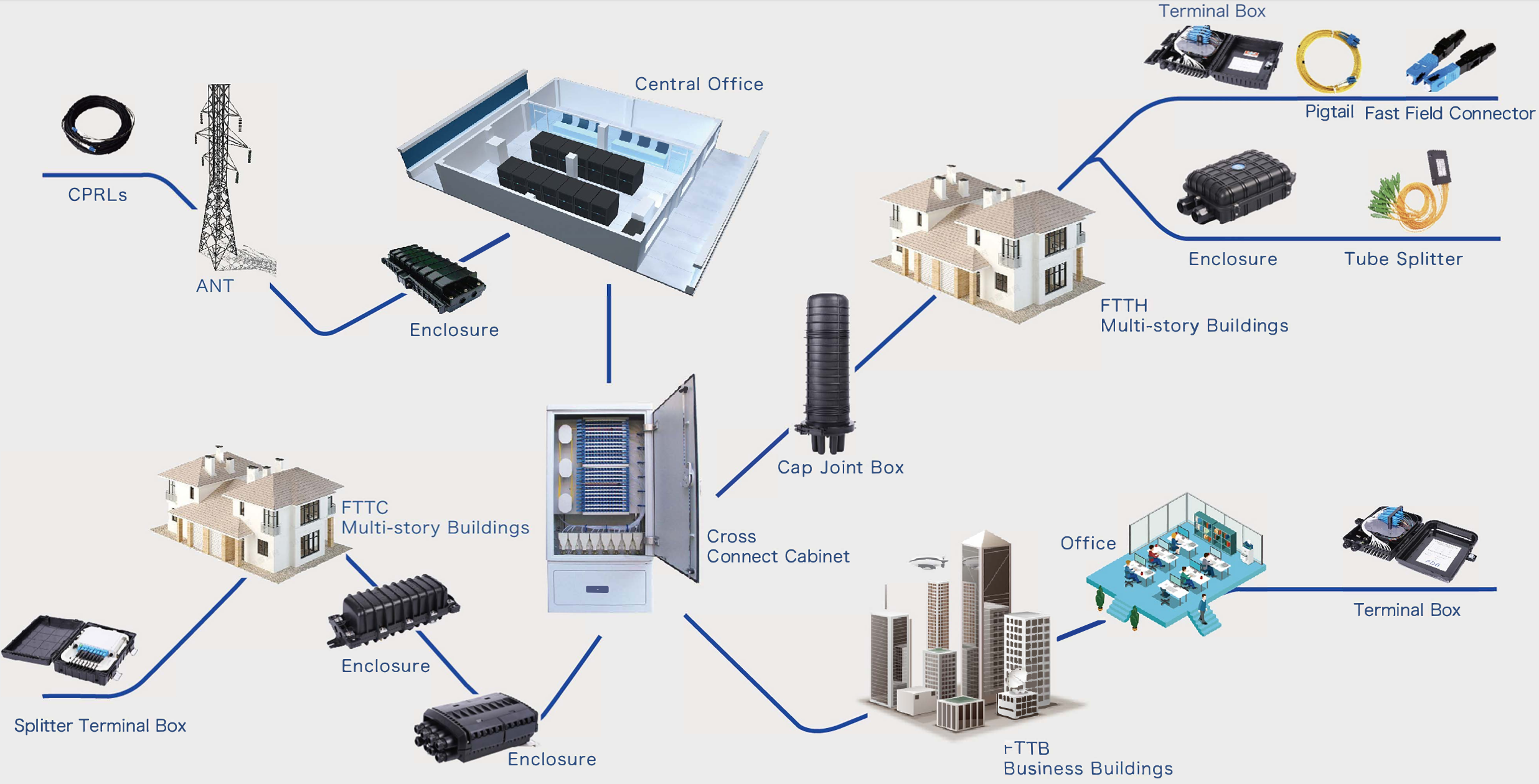


Protection of Spliced Fibers: The primary purpose of a fiber optic splice closure is to provide protection to the spliced optical fibers. It safeguards the delicate and vulnerable splices from environmental factors such as moisture, dust, dirt, and physical damage.
Longevity and Reliability: Fiber optic splice closures ensure the long-term reliability of the spliced fibers by creating a sealed and secure environment. This protection helps prevent signal loss, degradation, or interruption in data transmission, thereby ensuring uninterrupted network connectivity.
Environmental Resistance: Fiber optic splice closures are designed to withstand harsh environmental conditions. They are usually waterproof, dustproof, and resistant to UV radiation, temperature variations, and chemicals. This durability allows them to be used in different outdoor and indoor applications.
Easy Maintenance and Accessibility: Fiber optic splice closures facilitate easy access to the spliced fibers for maintenance, repairs, or future expansion. With removable trays or panels, technicians can conveniently access the fibers without disrupting the entire cable network.
Versatility and Adaptability: Fiber optic splice closures come in various sizes and configurations to accommodate different fiber counts and installation requirements. They can be used in aerial, underground, or underwater applications. Their versatility allows for flexibility and adaptability in network deployments.
We offer competitive prices for fiber optic splice closures. If you are interested, please leave a message!
Regular Inspection: It is important to conduct regular inspections of fiber optic splice closures to detect any signs of damage, such as loose or frayed fibers, corrosion, or moisture ingress. Inspections can be done visually or using specialized equipment to ensure the integrity of the closures.
Cleaning and Dust Control: Fiber optic splice closures should be kept clean to prevent dust and dirt buildup, which can adversely affect signal quality. Regular cleaning with non-abrasive materials and antistatic wipes can help maintain optimal performance.
Proper Cable Management: Effective cable management is essential for fiber optic splice closures. Properly organizing and securing the fiber cables within the closure minimizes strain and bending, reducing the risk of signal loss or damage to the fibers.
Documentation and Record-Keeping: Maintaining accurate documentation and records of fiber optic splice closures is crucial for effective management. This includes documenting the location, type, and status of closures, as well as any maintenance or repair activities performed.
Preventive Maintenance and Repairs: Implementing a preventive maintenance schedule helps identify potential issues before they cause significant disruptions. This may involve re-splicing fibers, replacing damaged components, or applying protective measures like sealing any gaps or breaches in the closure.
Additionally, training technicians on proper handling, installation, and maintenance procedures of fiber optic splice closures can ensure they are managed effectively. Periodic performance testing and monitoring can also be valuable for detecting any degradation or issues that need immediate attention. By following these maintenance and management practices, fiber optic splice closures can be optimally maintained, enabling reliable and efficient network operations.
Fusion Splicing
Fusion splicing is a widely used method in which the ends of two fiber optic cables are precisely aligned, then fused together using heat to create a continuous optical path. This method provides low insertion loss and high tensile strength.
Mechanical Splicing
Mechanical splicing involves aligning the fiber ends using a mechanical splice unit or alignment sleeve within the closure. It typically requires an index-matching gel or adhesive to reduce the light reflection at the joint. While it is less expensive than fusion splicing, it may have higher insertion loss and lower tensile strength.
Mass Fusion Splicing
Mass fusion splicing allows multiple fibers to be spliced simultaneously in a single operation. Specialized fusion splicing machines with multiple electrode arrays are used to align and fuse the fibers. This method is efficient for large-scale fiber deployments and can save time and labor costs.
Ribbon Splicing
Ribbon splicing is used for splicing multiple fibers, typically in the form of ribbon cables. The fibers are arranged in parallel ribbons and spliced together using either fusion or mechanical splicing techniques. Ribbon splicing enables quick and efficient splicing in high-density environments.
Heat-Shrink Splicing
Heat-shrink splicing involves aligning the fiber ends and protecting the splice with a heat-shrink tube. Heat is applied to the tube, causing it to shrink and create a secure and protective enclosure for the splice. This method is commonly used in field installations and allows for easy access for future maintenance or repairs.
 Call us on:
Call us on:  Email Us:
Email Us:  Wanhua Science and Technology Park, No. 528, Shunfeng Road, Donghu Street, Linping District, Hangzhou City, Zhejiang Province
Wanhua Science and Technology Park, No. 528, Shunfeng Road, Donghu Street, Linping District, Hangzhou City, Zhejiang Province